Ashtanga Yoga
Copyright 2012 Caroline Klebl, PhD
All rights reserved. No part of this publication may be reproduced, distributed or transmitted in any form or by any means, or stored in a database or retrieval system without the prior written permission of the author.
Photographer: Carolyn Strover
Layout and Design: Anastasia Hockinson,
Giyoung Park, Vilma Saldate, Bill JonasEditor: Emily Alp
Cover Design: Bill Jonas
Published by: Source of YogaBeverly Hills, CA
ISBN: 978-061556635-1
CONTENTS
Invocation15
Surya Namaskara 17
Standing Asanas61
Primary Series95
Intermediate Series154
Finishing Asanas233Yoga is a 5000 year old tradition,
which developed out of ancient Indianasceticism. Yoga is a Sanskrit word,which means union, but it is commonlyknown as spiritual discipline. Yoga is atangible method of attaining to liberationfrom suffering and to the realizationof supreme consciousness. There aresix main types of Yoga mentioned ineastern philosophy: Karma Yoga (theYoga of virtuous actions), Bhakti Yoga(the Yoga of love and devotion), JnanaYoga (the Yoga of knowledge), RajaYoga (meditation practice), Hatha Yoga(practice of yoga asanas [postures],pranayama [breathing techniques], mudras[sacred gestures] and kriyas [purificationtechniques]) and Tantra Yoga (recitation ofmantra [sacred syllables], visualization ofyantras [sacred diagrams], identificationwith deities and sexual practices).
Ashtanga Yoga, the eight steps ofrealization were described in the YogaSutras, a precise treatise on Yoga,which was compiled by the SagePatanjali over 2000 years ago. TheYoga Sutras are divided into four padas(chapters or quarters): the SamadhiPada, on consciousness; the SadhanaPada describing various methods ofyoga practice; the Vibhuti Pada, whichenumerates the internal practices ofconcentration, meditation and absorptionand the method of acquiring supernaturalpowers; and the Kaivalya Pada, whichreveals the ultimate state of liberation.
The eight steps of yoga, which AshtangaYoga refers to, are defined in the SadhanaPada, and individual steps are additionallyreferenced and described in detail
throughout the entire Yoga Sutras text.Ashtanga is a Sanskrit term consistingof two wordsAshta, translates aseight, and Anga, translates as limbs,aspects or steps. Yoga is the unificationof individual consciousness with supremeconsciousness. The eight aspects of Yogapractice are yama (moral codes), niyama(applied disciplines), asana (posture),pranayama (breath-control), pratyahara(withdrawal of the sense organs), dharana(concentration), dhyana (meditation)and samadhi (absorption). Yoga is theunification of individual consciousnesswith supreme consciousness, and the eightsteps of Ashtanga comprise structured andpowerful practices for anyone willing toachieve this state.
The yamas are the moral codes, whichensure beneficial social interactions.They free the mind and life of a yogapractitioner from undesirable thoughts,feelings and circumstances resultingfrom immoral actions. The yamasinclude, ahimsa (non-violence), satya(truthfulness), asteya (non-theft),Brahmacharya (guided by Brahman orGod) and aparighraha (non-hoarding).
The niyamas are those thoughts and actionsthat create a state of being that is conduciveto yoga. The niyamas include saucha(cleanliness), santosha (contentment), tapas(heat from the practice of austerities),svadhyaya (chanting in reference tothe study of supreme consciousness),Ishvara pranidhana (surrender to supremeconsciousness or God).
The asana and pranayama practices arethe gateway into the steps of AshtangaYoga. Asana practice is a tangiblemethod for strengthening the bodyand eliminating disease. Pranayamapractice awakens and purifies subtleenergy channels underlying the
physical form. The practice of asanaand pranayama, clears impuritiesout of the body and induces a
deeply meditative state, by whichdysfunctional behavioral patterns arenaturally abandoned.
In the Vibhuti Pada, the thirdchapter, of the Yoga Sutras, aseparation of the eight limbs ofAshtanga Yoga into BahirangaSadhanas (external practices) andAntaranga Sadhanas (internalpractices) is mentioned. TheBahiranga Sadhanas are comprisedof yama, niyama, asana, pranayamaand pratyahara. Pratyahara isthe discipline of stopping themind from making contact withobjects through the sense organs.Pratyahara eliminates distractions,thereby enabling the practice of thesubsequent Antaranga Sadhanasdharana, dhyana and samadhi.
Dharana is concentration in theform of binding of consciousnessto one place or object. Dhyana, ormeditation, is the exclusive extensionof consciousness to this one place ofobject. And samadhi occurs whenthere is only awareness of this oneplace or object and there is no moreawareness of ones self. Dharana,dhyana and samadhi taken togetherare called Samyama, which meanscontrol or restraint. By masteringSamyama the light of Prajna
(intuition or insight) shines forth.
The world-renowned yoga Guru,Sri K Pattabhi Jois, taught a precisemethod of asana and pranayamapractice that accesses the supremestate of liberated existence, which ismentioned on the Yoga Sutras. Henamed this style of yoga practiceAshtanga Yoga.
This method of asana practice was describedin the Yoga Korunta, a sacred text composedby Vamana Rishi. The Yoga Korunta hasbeen passed down in the tradition of GuruShishya Paramparaa succession of teachersand disciplesby Guru Rama MohanBrahmachari to Sri T Krishnamacharya, whoentrusted it to his disciple Sri K PattabhiJois in 1927. The Yoga Korunta emphasizesa precise method of asana practice, whichincludes hundreds of asanas and a specificpranayama sequence. In the text, it isinstructed that vinyasa is an essential elementof asana practice.
Vinyasa intimately links the inhaling andexhaling breath to the movement of the bodyin and out of the postures. The vinyasa orcontinuous movement between the posturescreates an internal heat that eases the bodyinto the various asanas. In the Yoga Koruntait is specifically advised not to practice asanawithout vinyasa.
The Ashtanga Yoga practice includeshundreds of asanas, which are divided intoprimary, intermediate and advanced series.The primary series or Yoga Chikitsa,is designed to eliminate disease. Theintermediate series, which is referred toas Nadi Shodhana, purifies the nadies orsubtle energy channels underlying thephysical form. The advanced series orSthira Bhaga, consists of 3 or 4 seriesof advanced asanas, that stabilize innerradiance. Sthira means steady and Bhagais an ancient God of love and prosperity.
In Ashtanga Yoga, the asanas arepracticed in sequential order, and arepreceded and concluded by a vinyasa.Each practice, of any series, begins withSurya Namaskara, a sequence of asanasalso known as Sun Salutations. Thereare two types of Surya NamaskaraAand Bthat are repeated five times eachprior to practicing individual asanas.Surya Namaskara is essentially a seriesof vinyasas; since each asana, exceptfor Adho Mukha Shvanasana, downwardfacing dog posture, is held for only amoment at the end of either the inhalingor exhaling breath, while the alternatinginhaling and exhaling breath is stretchedthroughout the movements betweenone asana and the next. Adho MukhaShvanasana is the only asana, whichis held for five breaths in each SuryaNamaskara.

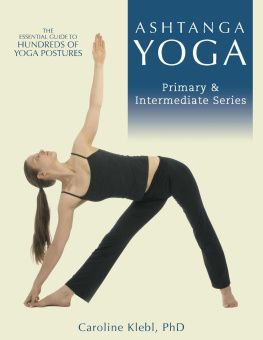
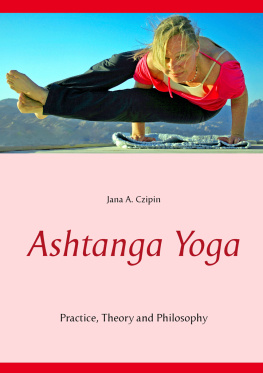
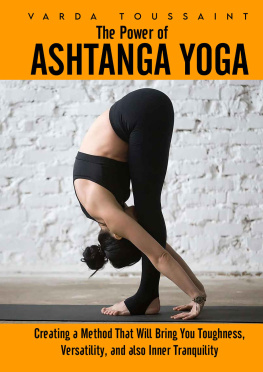
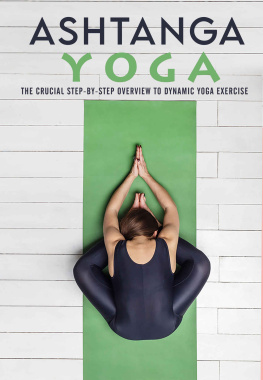
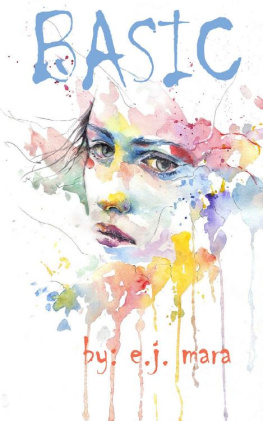

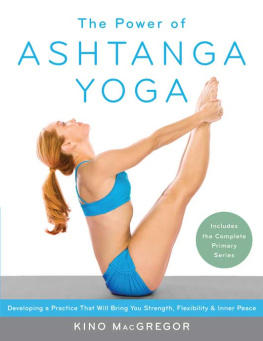

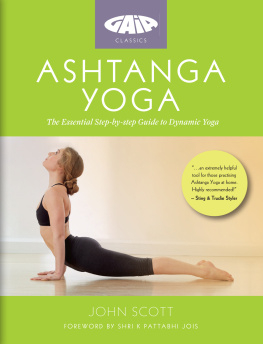
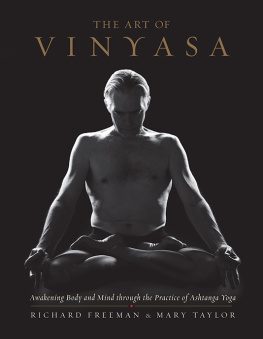
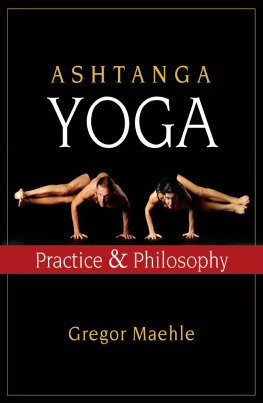
 Ganesha Yantra
Ganesha Yantra 